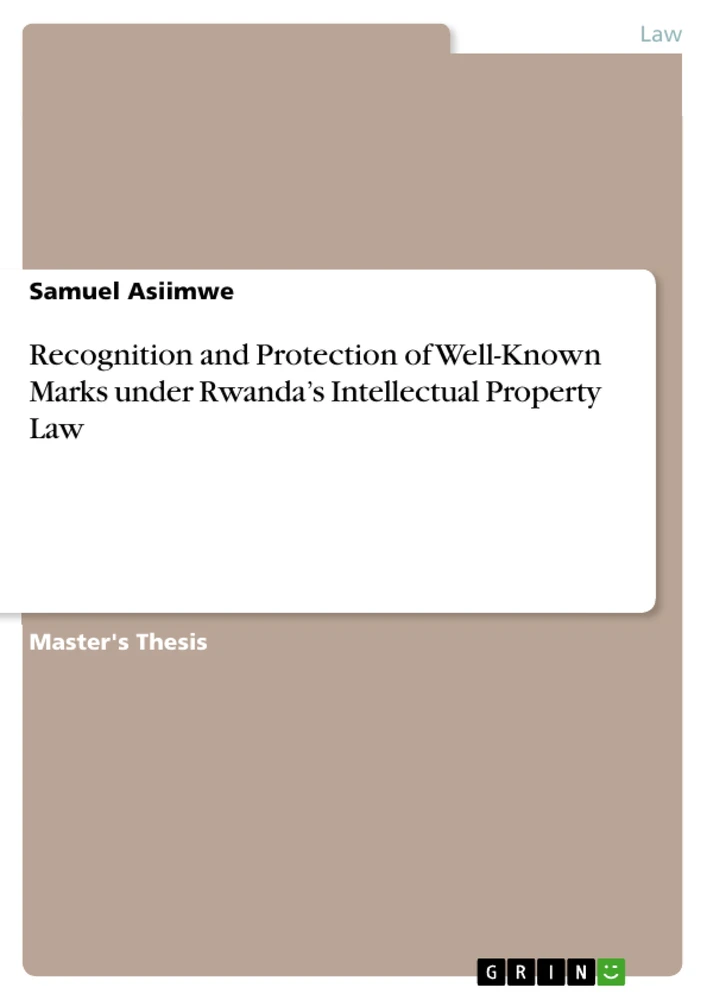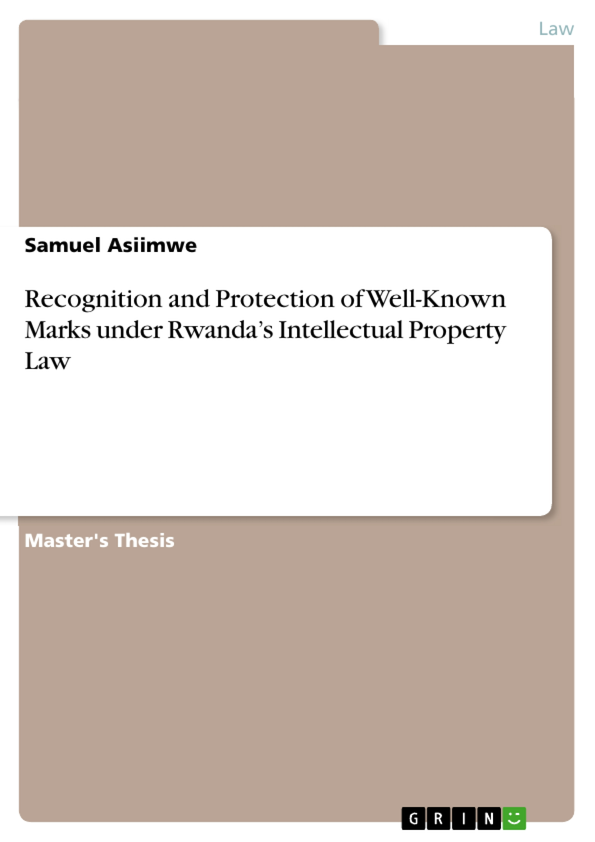This study critically examines the protection of well-known marks under Rwandan intellectual property law, identifying significant legal ambiguities and practical challenges. Although the law requires actual use and registration to recognize a mark as well-known, it fails to define the concept of "use", resulting in conflicting interpretations among legal scholars. Some argue for a broad interpretation that includes descriptive and non-source functions, while others advocate for a more limited approach. This uncertainty weakens the legal framework, leaving well-known marks vulnerable to trademark dilution, where the distinctiveness and reputation of a mark are impaired through its use on unrelated goods or services.
The study further highlights that Rwanda's IP legal regime lacks clarity and consistency in addressing the protection of foreign and unregistered well-known marks, particularly in light of international obligations related to fair competition, national treatment, and most-favored-nation principles. The absence of specific ministerial guidelines governing the recognition and protection of well-known marks exacerbates this issue. Moreover, the law's insistence on territorial use contradicts global trends and best practices, such as Australia's "defensive trademark" system, which acknowledges reputation without actual use.
Globalisation has challenged traditional notions of territoriality in trademark law, prompting a need for legal harmonisation. This research underscores the importance of aligning Rwandan law with international standards to ensure the effective protection of well-known marks. Through comparative legal analysis, particularly with reference to common law jurisdictions, this study seeks to propose legal reforms that address current inconsistencies and enhance the country's commitment to fair and competitive trademark practices.
Table of Contents
- General Introduction
- Background of the study
- Problem statement
- Research questions
- Research objectives
- Research methodology
- Interests of the Study
- Scope of the study
- Structure of the study
- Chapter One: Theoretical Conceptions and Legal Perspectives of Trademark Protection
- Section One: Understanding Key Terms
- Section Two: Preconditions of Trademark Protection
- Section Three: Trademark Rights Acquisition
- Section Two: Principles underpinning well-known mark protection
- Sub-Section Three: Fair Competition Standards/Global Consensus on Well-known Mark Protection
- Section Four: Unfair Trademark practices and Well-known
- VII. Standard to Determine Trademark Dilution
- Chapter Two: Problem of Protection of Well-Known Marks in Rwanda
- Section 1: Legal Approaches of well-known mark protection
- Section II: Protection of well-known marks in the diverse Legal Instruments
- Section III: Infringement Remedies of well-known marks and remedies Under Rwandan Law
- Section IV: Recommendations: Legal Approaches of well-known mark protection
Objectives and Key Themes
This study aims to critically analyze the protection of well-known trademarks under Rwandan intellectual property law, identifying legal ambiguities and practical challenges. It explores the inconsistencies in the current legal framework and proposes legal reforms to align Rwandan law with international standards for fair and competitive trademark practices. * The definition and interpretation of "use" in relation to well-known marks. * The protection of foreign and unregistered well-known marks in Rwanda. * The tension between territoriality and global trends in trademark law. * The need for legal harmonization to ensure effective protection of well-known marks. * The effectiveness of current infringement remedies under Rwandan law.Chapter Summaries
**Chapter One: Theoretical Conceptions and Legal Perspectives of Trademark Protection**: This chapter lays the groundwork for understanding trademark protection, defining key terms such as "trademark" and "well-known mark." It examines the preconditions for trademark protection, including distinctiveness, functionality, and the likelihood of confusion. The chapter then delves into the different systems for acquiring trademark rights: the first-to-file and first-to-use systems. It further explores principles underpinning well-known mark protection, such as territoriality and specialty, and analyzes fair competition standards and global consensus on this matter. Finally, it addresses unfair trademark practices and the standard for determining trademark dilution, providing a comprehensive theoretical framework for the subsequent analysis of Rwandan law. **Chapter Two: Problem of Protection of Well-Known Marks in Rwanda**: This chapter focuses on the practical challenges of protecting well-known marks within the Rwandan legal system. It assesses the legal approaches to well-known mark protection, analyzing how these marks are assessed under Rwandan law and the role of international instruments like the Paris Convention and the TRIPS Agreement. The chapter also examines infringement remedies available under Rwandan law, including administrative and judicial remedies such as opposition to registration, invalidation of registration, and trademark infringement actions. It critically analyzes the existing legal framework, highlighting its shortcomings and inconsistencies, particularly regarding the protection of foreign and unregistered well-known marks, and proposes recommendations for legal reform to enhance the protection of these crucial intellectual property assets within Rwanda’s legal system.Keywords
Well-known marks, trademark protection, Rwandan intellectual property law, trademark dilution, territoriality, fair competition, legal harmonization, infringement remedies, Paris Convention, TRIPS Agreement, legal reform.
Frequently asked questions about the language preview
What is this document about?
This document is a language preview containing information about a study analyzing the protection of well-known trademarks under Rwandan intellectual property law. It includes a table of contents, objectives and key themes, chapter summaries, and keywords.
What is included in the table of contents?
The table of contents outlines the structure of the study, including a general introduction covering background, problem statement, research questions, objectives, methodology, interests, scope, and structure. It also lists chapters focusing on theoretical and legal perspectives of trademark protection, and the problem of protecting well-known marks in Rwanda.
What are the main objectives and key themes of the study?
The study aims to critically analyze the protection of well-known trademarks under Rwandan intellectual property law. Key themes include the definition of "use," the protection of foreign and unregistered marks, the tension between territoriality and global trends, the need for legal harmonization, and the effectiveness of infringement remedies.
What does Chapter One cover?
Chapter One lays the theoretical groundwork for understanding trademark protection. It defines key terms, examines preconditions for protection (distinctiveness, functionality, likelihood of confusion), discusses trademark rights acquisition systems, and analyzes principles underpinning well-known mark protection, fair competition standards, and unfair trademark practices.
What does Chapter Two focus on?
Chapter Two focuses on the practical challenges of protecting well-known marks within the Rwandan legal system. It assesses legal approaches to protection, analyzes the role of international instruments (Paris Convention, TRIPS Agreement), examines infringement remedies, and proposes recommendations for legal reform.
What are some of the keywords associated with this study?
Keywords include: Well-known marks, trademark protection, Rwandan intellectual property law, trademark dilution, territoriality, fair competition, legal harmonization, infringement remedies, Paris Convention, TRIPS Agreement, legal reform.
What is the main purpose of the research?
The main purpose of the research is to identify legal ambiguities and practical challenges in the protection of well-known trademarks under Rwandan intellectual property law and propose legal reforms to align Rwandan law with international standards for fair and competitive trademark practices.
Does the study address the protection of foreign and unregistered trademarks?
Yes, the study specifically addresses the protection of foreign and unregistered well-known marks in Rwanda, highlighting it as a key theme and a point of analysis within the Rwandan legal framework.
What kind of remedies are examined in the study?
The study examines administrative and judicial remedies available under Rwandan law, including opposition to registration, invalidation of registration, and trademark infringement actions.
- Quote paper
- Samuel Asiimwe (Author), 2022, Recognition and Protection of Well-Known Marks under Rwanda’s Intellectual Property Law, Munich, GRIN Verlag, https://www.grin.com/document/1594418



